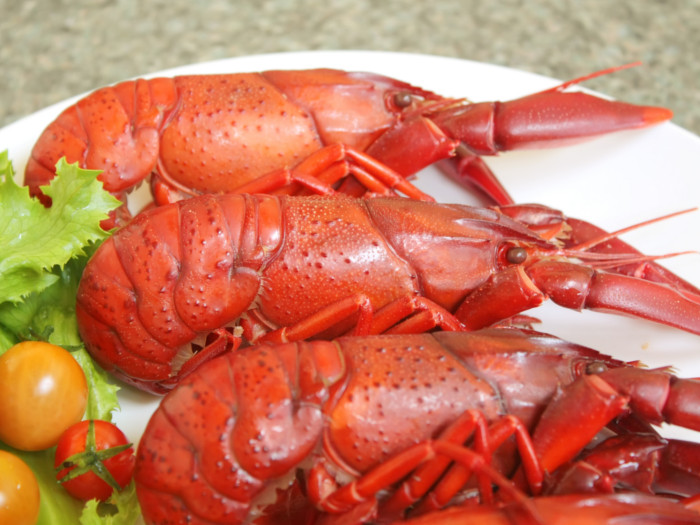Crawfish may not always look appetizing, but it is actually a delicious and nutritious type of seafood to add to your diet. Many species are found exclusively in North America and are particularly abundant in Louisiana and Mississippi, where they feature heavily in the local cuisine.
What is Crawfish or Crayfish?
Crawfish, also known as crayfish, are small crustaceans, from a variety of families in the Arthropoda phylum, which looks similar to lobsters. They usually only grow to about 3-4 inches long, and nearly all live in freshwater environments. As crustaceans, they are considered shellfish by the food and fishing industries and are extremely good for your overall health. [1]

Crayfish are freshwater crustaceans resembling small lobsters. Photo Credit: Shutterstock
| Serving Size : | |
|---|---|
| Nutrient | Value |
| Water [g] | 79.37 |
| Energy | 82 |
| Energy [kJ] | 343 |
| Protein [g] | 16.77 |
| Total lipid (fat) [g] | 1.2 |
| Ash [g] | 1.2 |
| Calcium, Ca [mg] | 60 |
| Iron, Fe [mg] | 0.83 |
| Magnesium, Mg [mg] | 33 |
| Phosphorus, P [mg] | 270 |
| Potassium, K [mg] | 296 |
| Sodium, Na [mg] | 94 |
| Zinc, Zn [mg] | 1.76 |
| Copper, Cu [mg] | 0.69 |
| Manganese, Mn [mg] | 0.52 |
| Selenium, Se [µg] | 36.7 |
| Vitamin C, total ascorbic acid [mg] | 0.9 |
| Thiamin [mg] | 0.05 |
| Riboflavin [mg] | 0.09 |
| Niacin [mg] | 2.28 |
| Pantothenic acid [mg] | 0.58 |
| Vitamin B-6 [mg] | 0.08 |
| Folate, total [µg] | 44 |
| Folate, food [µg] | 44 |
| Folate, DFE [µg] | 44 |
| Choline, total [mg] | 80.9 |
| Vitamin B-12 [µg] | 2.15 |
| Vitamin A, RAE [µg] | 15 |
| Retinol [µg] | 15 |
| Vitamin A, IU [IU] | 50 |
| Vitamin E (alpha-tocopherol) [mg] | 1.5 |
| Vitamin K (phylloquinone) [µg] | 0.1 |
| Fatty acids, total saturated [g] | 0.18 |
| 14:0 [g] | 0.01 |
| 16:0 [g] | 0.11 |
| 18:0 [g] | 0.05 |
| Fatty acids, total monounsaturated [g] | 0.24 |
| 16:1 [g] | 0.03 |
| 18:1 [g] | 0.15 |
| 20:1 [g] | 0.01 |
| 22:1 [g] | 0.05 |
| Fatty acids, total polyunsaturated [g] | 0.37 |
| 18:2 [g] | 0.09 |
| 18:3 [g] | 0.03 |
| 18:4 [g] | 0 |
| 20:4 [g] | 0.06 |
| 20:5 n-3 (EPA) [g] | 0.12 |
| 22:6 n-3 (DHA) [g] | 0.05 |
| Cholesterol [mg] | 133 |
| Tryptophan [g] | 0.23 |
| Threonine [g] | 0.68 |
| Isoleucine [g] | 0.81 |
| Leucine [g] | 1.33 |
| Lysine [g] | 1.46 |
| Methionine [g] | 0.47 |
| Cystine [g] | 0.19 |
| Phenylalanine [g] | 0.71 |
| Tyrosine [g] | 0.56 |
| Valine [g] | 0.79 |
| Arginine [g] | 1.46 |
| Histidine [g] | 0.34 |
| Alanine [g] | 0.95 |
| Aspartic acid [g] | 1.73 |
| Glutamic acid [g] | 2.86 |
| Glycine [g] | 1.01 |
| Proline [g] | 0.55 |
| Serine [g] | 0.66 |
| Sources include : USDA [2] | |
Crawfish Nutrition
Although eating these shellfish for the first time can seem strange, they prove themselves to be nutritionally beneficial. They have a very high number of calories and are particularly rich in protein. They contain very little fat and no carbohydrates. Like all seafood, they contain omega-3 oils, which are essential for a healthy diet. [3]
Benefits
The benefits of crayfish include healthier bones, reduced risk of heart diseases, lower risk of Alzheimer’s, improved brain health. It also helps relieve depression. [4]
- Calcium and phosphorus present in crawfish promote healthy and strong bones.
- Prevents cardiovascular diseases and encourages heart health.
- Optimal brain health
- Lower levels of depression
- Reduced risk of Alzheimer’s.
- Reduces inflammation all over the body. This can result in healthier skin, more mobile joints, and increased regeneration of cells. [5]
Uses
There are many delicious recipes to choose from, including crawfish boiled and grilled with spices, as well as stews like étouffée, jambalaya or gumbo. [6]
Crawfish vs Lobster
- Appearance: Lobsters and crawfish look very similar to a novice, with the exception of the size. Lobsters tend to be 8-24 inches long, while this shellfish is only 3-4 inches.
- Taste: If prepared similarly, lobsters and crawfish taste very much the same.
- Nutrition: Both lobster and crawfish are high in calories and protein, with little fat and carbs.
- Uses in Cooking: Crawfish are often prepared in stews and spicy dishes, whereas lobsters are generally eaten with more mild ingredients, such as butter or lemon.
Word of Caution: These shellfish are high in cholesterol, and a serving size contains about 30% of the recommended daily intake, so people with high cholesterol should pay close attention to the inclusion of these shellfish in their diet.
